The construction of houses consists of many processes. But it is on the quality of the foundation construction that the operational characteristics of the structure and its durability will depend. An important point, which in almost all situations is performed before creating the base, is the flooring of the bedding layer. What are foundation pillows, why are they needed and what types of them are, we will consider further.
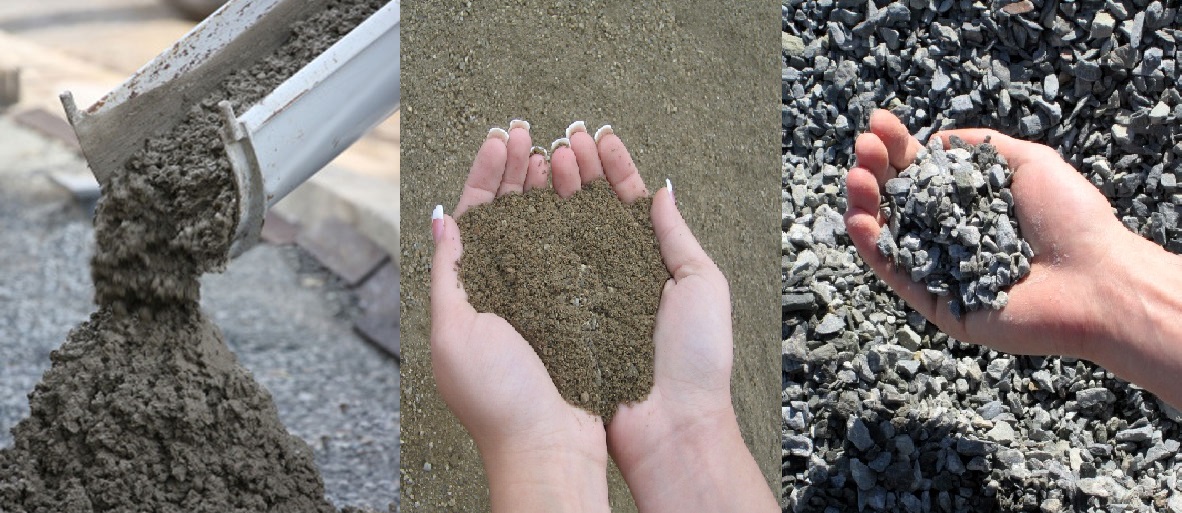
A foundation pillow is a kind of pad between it and the ground surface. It consists of sand or gravel, which has been previously filled into a trench and compacted.
|
product name |
Dimensions (mm) |
Weight (kg) |
||
| FL-6-12-4 | ||||
| FL-6-24-4 | ||||
| FL-8-12-2 | ||||
| FL-8-24-2 | ||||
| FL-10-8-2 | ||||
| FL-10-12-2 | ||||
| FL-10-24-2 | ||||
| FL-12-8-2 | ||||
| FL-12-12-2 | ||||
| FL-12-24-2 | ||||
| FL-14-8-2 | ||||
| FL-14-12-2 | ||||
| FL-14-24-2 | ||||
| FL-16-12-2 | ||||
| FL-16-24-2 | ||||
| FL-20-8-2 | ||||
| FL-20-12-2 | ||||
| FL-24-8-2 | ||||
| FL-24-12-2 | ||||
| FL-28-8-2 | ||||
| FL-28-12-3 | ||||
| FL-32-8-2 | ||||
| FL-32-12-2 | ||||
The type of building material used to create the bedding layer is determined based on the characteristics of the soil in a particular area and the weight of the future structure. Sand and crushed stone must comply with the recommendations of GOST.
Such a gasket performs the following functions:
- With the help of medium and coarse material, the surface of the base is leveled under the foundation - this is necessary for the most even distribution of the load from the weight of the structure on the ground cover.
- Sand or gravel particles replace soil, with which the foundation is not recommended to contact.
- A layer of sand is often used to protect reinforced concrete structures from the destructive influence of excess soil moisture.
It turns out that the presence of a sand and gravel cushion is simply necessary for the construction of durable and stable structures.
Types of pillows for the foundation
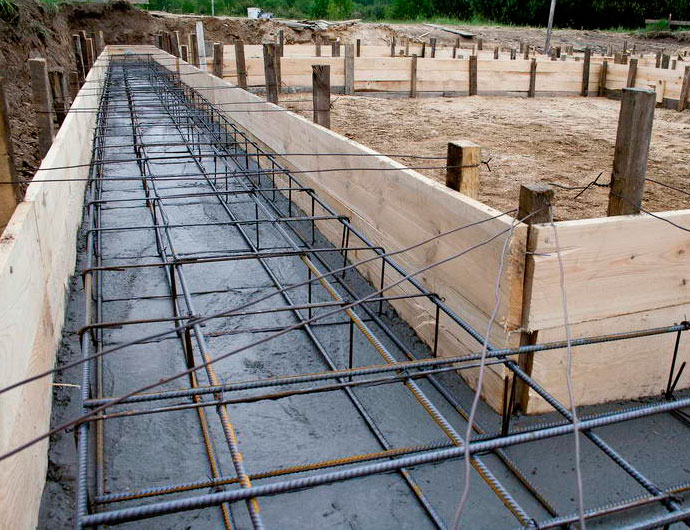
Create a support under the base from the following materials:
- Sand;
- Crushed stone;
- Concrete.
Let's dwell on each type specifically and consider it in more detail.
Sandy
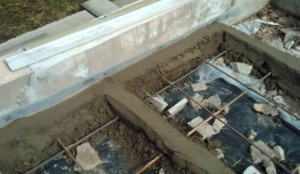
It is used when necessary to invest in a minimum budget. Also, this building material is available in almost any region and has excellent performance for such use.
Scope of use:
- Locations with a deep level of occurrence groundwater... Otherwise, there is a need to arrange the drainage system - this will protect the sand layer from erosion, and concrete from gradual destruction.
- Construction of houses or other structures made of materials with low actual weight. The sandy structure does not withstand high loads, so it is always worth considering the efficiency of use in a particular case.
- The sand cushion is optimal for single-storey structures.
For the construction of the pillow, you must use only coarse sand. It is strictly forbidden to use finely dispersed for such purposes.
Carrying out its installation, or rather filling the material, you need to monitor the evenness of its surface and the quality of the ramming. The layer should be within 20-40 cm.
Crushed stone

It can be used from crushed stone, as well as for other types of base, if necessary, equip a surface that is able to withstand high loads.
Depending on the conditions of use, crushed stone of different fractions and from various stone breeds can be used.
The most durable pillow is a layer of medium-grain granite..
Concrete preparation with such material is performed as follows:
- To begin with, the surface of the soil is leveled with sand. It is enough to fill and tamp the layer within 11-15 cm - it is used exclusively to increase the density of the next layer to the soil surface. It is great if specialized equipment is used for ramming. As mentioned earlier, it is worth using exclusively coarse sand.
- After the compaction of the first layer has been carried out and its surface is as flat as possible, the crushed stone is backfilled with the fraction optimal for specific conditions. The layer width in most cases is 20 cm.
- Crushed stone is also compacted using special equipment.
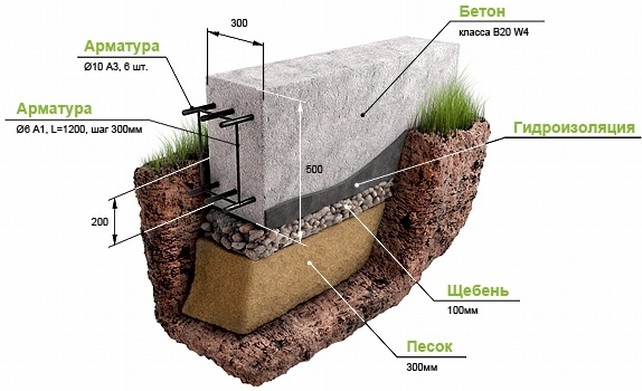
To create an optimal pillow, the dimensions of the foundation are calculated and its bedding is created 30 cm more than the obtained value - only in this case it is possible to achieve the stability of the structure under the influence of the weight of the structure.
Concrete
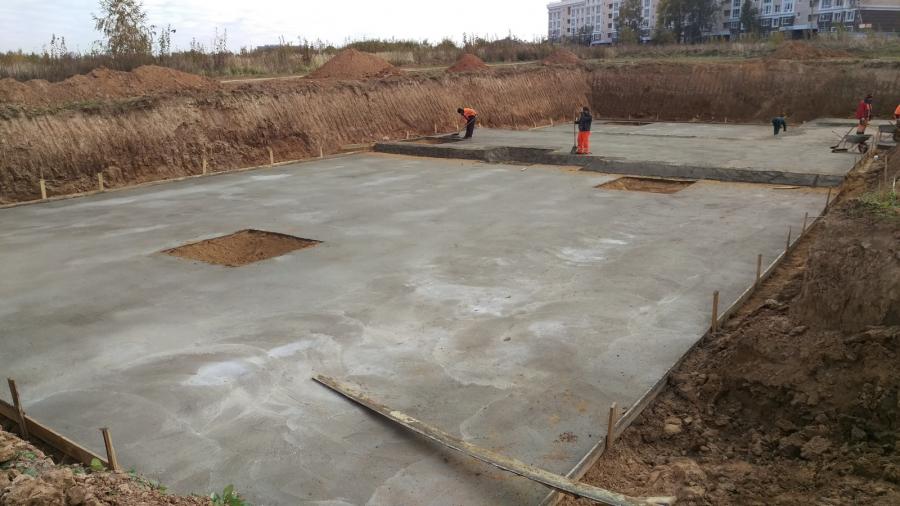
The option is rightfully considered the most reliable and is used in cases where it is necessary to obtain a base with the maximum ability to withstand the bearing load. The disadvantage of preparation using concrete can be called its cost - this is due to the need to purchase an additional amount of cement of a certain brand.
Installation is performed according to the following algorithm:
- To begin with, a small layer (about 10 cm) of rubble is poured into the already prepared foundation pit. It performs the task of rough bedding. Particular attention should be paid to its ramming - it must be performed at the highest level. Naturally, this cannot be achieved without special compacting units.
- The formwork is being installed from boards at a level that is equal to the lower mark of the future foundation - this allows concrete preparation to be carried out with an accuracy of half a centimeter. Considering the mass of concrete, it is worth taking care of strengthening the structure of the boards - reliable fixation will prevent deformations and uneven spread of the solution.
- Depending on the specific construction conditions, reinforcement with bars of the required section is carried out. As a rule, they are tied in a grid with a step of 1.5-2 cm.
- The trench, ready for pouring, is filled with cement mortar. To seal it, special vibrating-type devices (called a mace) are used - under its influence, air bubbles come out.
- Surface leveling in progress concrete preparation.

Although such a pillow requires the maximum amount of material costs, in some situations it is impossible to do without it.
Reinforced concrete pillow under strip foundation created taking into account special requirements, which should be considered as a separate item.
GOST for reinforced concrete (FL) slabs
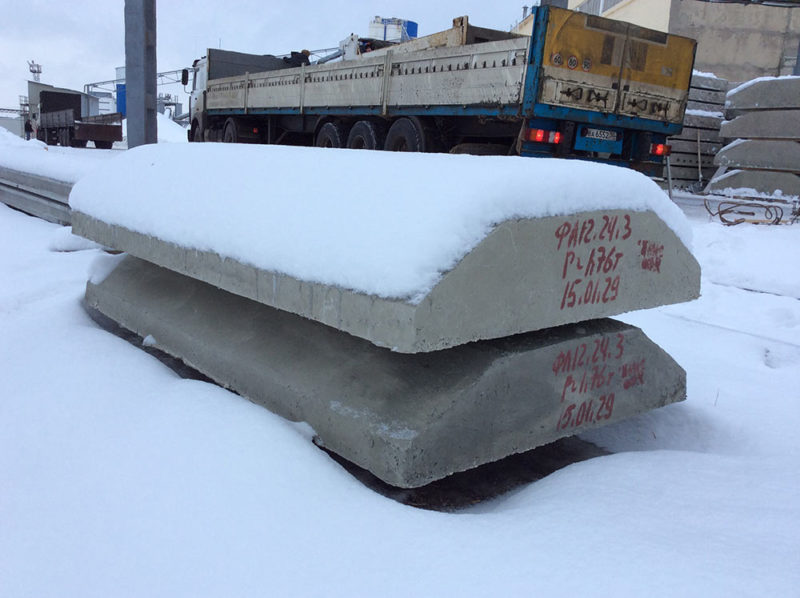
The GOST requirements regulate the creation of reinforced concrete slabs on which foundation blocks - this method of construction is especially relevant for multi-storey construction.
For self-study, it is worth studying GOST 13580-85 - it contains all the necessary information about the FL.
FL groups according to GOST
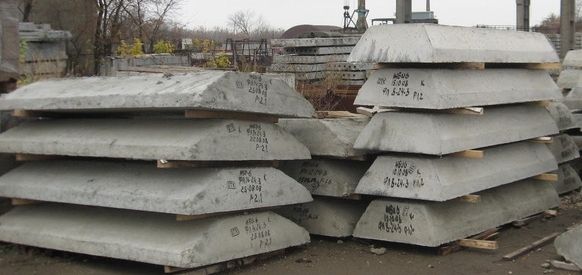
The presence of FL is necessary for:
- Creation of a structure with a basement;
- High density load-bearing walls (relevant when heavy blocks are used for construction);
- The presence in the structure of reinforced concrete partitions, which are large in size and weight;
- Holding construction process in areas with unstable soils, characterized by shear or settlement.
Installation of FL in accordance with GOST
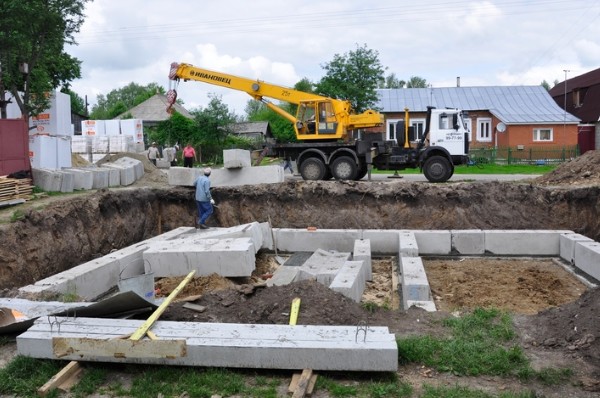
Installation of reinforced concrete cushion (FL) is carried out in cases of construction of a strip foundation from special building elements - FB (foundation blocks). At the same time, GOST recommends constructing FL from the same materials as building blocks.
It should be noted that the installation is carried out in the following sequence:
- Preparing the future site for construction and digging a trench.
- All surfaces of the trench are leveled, and the bottom plane is compacted using special equipment.
- A layer of sand and gravel is filled up. They also condense.
- Based on the calculations of the FL and what its dimensions will be, slabs and blocks are delivered to the construction site.
- With the help of a construction crane, the plates are installed.
- When the FL is assembled, it is reinforced.
- FBS is being installed. Blocks are installed with dressing.
- The laying of waterproofing materials and backfilling are in progress.

Note. For the construction of a prefabricated foundation, it is necessary to use block elements, the dimensions and strength characteristics of which correspond to GOST. Otherwise, the installation will be performed in contravention of the requirements, and the FL will not have the required bearing capacity.
Highlights when constructing a foundation cushion

- The surface of the concrete preparation should be checked using the building level - this will be the guarantor of the evenness of the surface of the future foundation;
- To lay out supports under the walls of a structure, it is preferable to use reinforced concrete elements of the same brand;
- It is necessary to perform a high-quality dressing.
The larger the dimensions and characteristics of the blocks according to GOST, the higher their price.
Now you know from what materials, and on what principle the pillow under foundation slab and tape. When using concrete and building materials, be sure to check their compliance with GOST. Installation should also be carried out taking into account all the points that were given in this article - the stability and reliability of the future home will depend on the quality of the pillow.
Foundation pillow updated: February 1, 2017 by the author: zoomfund
Read onThe lowest foundation layer is the pillow. It is designed to provide a solid and level surface for the future foundation. A concrete cushion under the foundation is the main basis of the entire foundation and future residential or industrial building.
Types of pillows
I would like to note right away that you should not confuse the base itself and the pillow under it. She's just part of the foundation. The foundation itself plays a huge role for the entire structure of the future building. This is an indisputable fact. This is the main pillar on which all the elements of the building are located. Therefore, it is he who is subjected to the most maximum loads not only from the side of the building, but also from the side of the soil in which it is located. It is quite clear that for a house made of timber or wood, you can use a strip foundation of a lighter structure than for a massive residential two or three-story building. In the latter case, it is by no means possible to save on the materials used.
So, what is a concrete pad is now known, but what materials are needed for its device should be considered in detail. There are three types of pillows: 
- sandy - represents the most economical option and is used mainly for light one-story construction of houses from timber or wood. The thickness of the sand layer should be at least 25 cm. Only in this case the base will fulfill its functional purpose, reliably protecting the foundation of the building.
- crushed stone pillow. This material has higher strength characteristics, and accordingly, it can be used for two-story buildings. In addition, such a base contributes to a more even distribution of loads over the entire surface. The most important thing when arranging such foundations is to very carefully tamp the layer of sand or gravel. The looseness of the material can lead to the subsidence of the foundation in the future.
- the use of a concrete pad during the construction of the base is the most reliable base option. Its only drawback is its high cost compared to other types. But, you see, the savings in the construction of the foundation are simply unacceptable. The main value is its immediate advantage - high strength indicators. Therefore, if you are planning to build a house from bricks or foam blocks. you will have to take care of the construction of the concrete base.
How to make a concrete pad

You can make a concrete base for the foundation yourself. At the first stage, it is necessary to check the evenness of the bottom, the dug trench and make sure that the soil at the bottom is thoroughly compacted.
The next step is to erect the formwork. It can be made of thin wooden boards or boards. The height of the formwork must be equal to the height of the future foundation. A concrete cushion for the foundation should be 30 cm high, this is the most optimal option. Ideally, it is advisable to lay a reinforcing cage in the base under the foundation to increase strength.
In order for the concrete base to be strong and reliable, you need to take care of the dimensions. They must be calculated with great care. Its area must certainly be larger than the area of \u200b\u200bthe foundation itself. It is desirable that it protrudes at least 15 cm beyond its edges. And do not forget that the used reinforcement should rise above the base surface by 30 cm for adhesion to the foundation itself.
Why do you need a concrete pillow
The use of a concrete pad is necessary on problematic soils prone to heaving. The additional base increases the support area of \u200b\u200bthe foundation itself. And of course, in this version it is necessary to arrange a concrete base.
At the preliminary stage of marking work, difficulties often arise when marking the corners of the future foundation. To facilitate the process, you should initially outline the two extreme corners of any base wall. To quickly mark the other two corners, you need to calculate the length of the foundation diagonal. Thanks to this, the position of the other two corners can be determined very accurately using the project of the future house.
Formwork device
After all the corners of the future base have been accurately marked and checked more than once, you can start installing the formwork. In order for the boards from the boards to hold firmly and not to move, they can be fixed using U-shaped brackets.
The formwork must be installed so that the walls of the base itself are exactly in the center of its cushion. When erecting the formwork, be sure to check the right angle at the intersection of the extreme corners of the foundation.
If, during the joining of the boards, large gaps are obtained in some places, they can be closed by placing a small board, nailing. You should not pay attention to the appearance of the pillow, because due to the unevenness of the formwork, it may not be entirely even. The most important thing is to comply with the calculated indicators and ensure strength.

When the installation of the formwork is completed, it is advisable to fill in some soil in its weak points. As a rule, these are the joints of individual boards. Thereby concrete mortar will not seep under the formwork.
Reinforcement cage laying
When the formwork is ready, concrete mortar is poured into it. When deciding how to make a concrete cushion under the foundation, one must not forget about the reinforcing cage, which helps to increase the strength of the cushion. When the concrete is completely poured into the formwork to the required level, two rows of steel bars are laid along the entire perimeter of the base pillow.
The reinforcement is laid on top of the still wet concrete that has not had time to grab at a distance of 15 cm from the walls of the formwork. Next, they must be drowned in a concrete solution to a depth of about 20 cm. In order not to leave air bubbles in the solution, which were formed as a result of the immersion of the rods, the concrete is carefully bayonetted.
At the last stage of the construction of a concrete cushion, it is necessary to carefully level the surface with tools. The surface of the base is then rubbed. This contributes to the fact that all dust and dirt after removing the formwork is easily removed from the surface of the pillow.
In some cases, builders in the middle of the sole, in the concrete that has not yet hardened, form a groove along the center centerline. It contributes to the fact that in the future, the base wall will more firmly and reliably adhere to the cushion under it. The dimensions of the recess are 8 cm in width and 3 cm in depth.
Most often, the adhesion of the sole and the foundation is carried out by means of reinforcement bars, which are left in an upright position at a height equal to the height of the base itself.
Before dismantling the formwork, it is advisable to mark the position of each corner of the future base on the upper edge of the pillow. This will be a guideline when it will be necessary to install the formwork for the construction of the base itself.
Concrete strip foundation and sole
A concrete pad for a strip foundation, undoubtedly more solid foundation for the foundation, unlike sand or crushed stone, but it, being an important element of the foundation, must always comply with the following parameters.
- The foot area should always be larger than the foundation area. At least 30 cm 9 15 cm from each edge).
- The reinforcement rods should be at least 30 cm above the level of the sole surface. This will increase the adhesion of the pad and the base.
- If you are in doubt about the size, then you can adhere to standard norms. Height 30 cm. Width 60 cm. Such a pillow is suitable both for the foundation for a cottage and for the foundation of a high-rise building.
DIY foundation for foundation
A do-it-yourself concrete pillow under the foundation can be erected for any building structure. In order for the foundation to be reliable, durable and stand long years it is necessary to adhere to the most basic rules and remember that low-quality materials, like incorrect calculations, can lead not only to deformations, but also to the destruction of a building.
The cracks that appear on the walls indicate that the base needs major repairs. But such a repair will "cost a pretty penny" to every owner who has saved on material.
Even if you are building a house from a tree or a bar of a small area, you can arrange a concrete sole on one or two floors. Your design will only benefit from this. Of course, a concrete base is an expensive pleasure, but is it worth saving on quality, which in the future will contribute to the fact that your house will stand for many decades?
The foundation is not only the foundation of any building, but also the guarantor of the durability and strength of the building. Exactly right choice and adherence to a strict sequence of work, as well as a competent selection of materials used in the construction of the foundation, guarantee its reliability and compliance with the required quality standards. The main goal of this part of the house is to provide the future structure with a stable and strong site. A properly prepared and laid sand and gravel cushion under the foundation is able to provide it with a lesser degree of sediment. Thus, a reliable pillow helps to significantly improve its quality indicators.
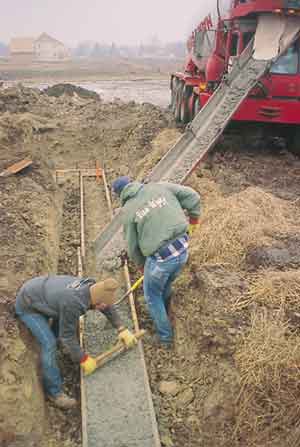 In the event that the construction of the foundation is carried out without observing the necessary building codes and contrary to the existing and time-tested rules, the constructed building in a very short time can become completely unsuitable for living. At the same time, cracks appear on the surfaces of the walls, the window frames are warped, the doors cease to close tightly. All this leads to the appearance of mold, dampness, drafts.
In the event that the construction of the foundation is carried out without observing the necessary building codes and contrary to the existing and time-tested rules, the constructed building in a very short time can become completely unsuitable for living. At the same time, cracks appear on the surfaces of the walls, the window frames are warped, the doors cease to close tightly. All this leads to the appearance of mold, dampness, drafts.
Renovated and finished premises are losing their attractiveness. Owners of such unfortunate buildings have to invest additional funds, time and money in unforeseen renovations.
Compliance with all foundation construction requirements will help to avoid disappointment. And its correctness depends on how exactly the sand and gravel cushion was made for the foundation. It is rightfully considered the key to a strong and solid foundation. The pillow ensures the complete absence of contact between building materials and construction objects with the foundation itself, which, in turn, excludes the appearance of various deformations. Thanks to the presence of a well-chosen and prepared pillow, the building (at its very bottom) rises high in terms of groundwater.
A mixture of sand and gravel is one of the most popular and commonly used building materials. Both of these components, mixed in strict accordance with the recommended proportions, are very often used for the construction of homes, shops and other buildings. This seemingly simple composition is one of the best base options. It guarantees the strength of the mix of concrete or cement mortar.
Why do you need a foundation pillow?
Those who are thinking about making the foundation for the construction themselves should pay attention to the clearly formed building rules regarding this issue. First of all, it is important to comply with all the requirements for such a stage of work as the device of a sand and gravel cushion. In addition to a cushion made of a combination of sand and gravel, cushions for a foundation made of concrete and crushed stone are common. As a rule, a concrete pad is required only when performing a reinforced belt under the FBS blocks or when further expanding the foundation walls. 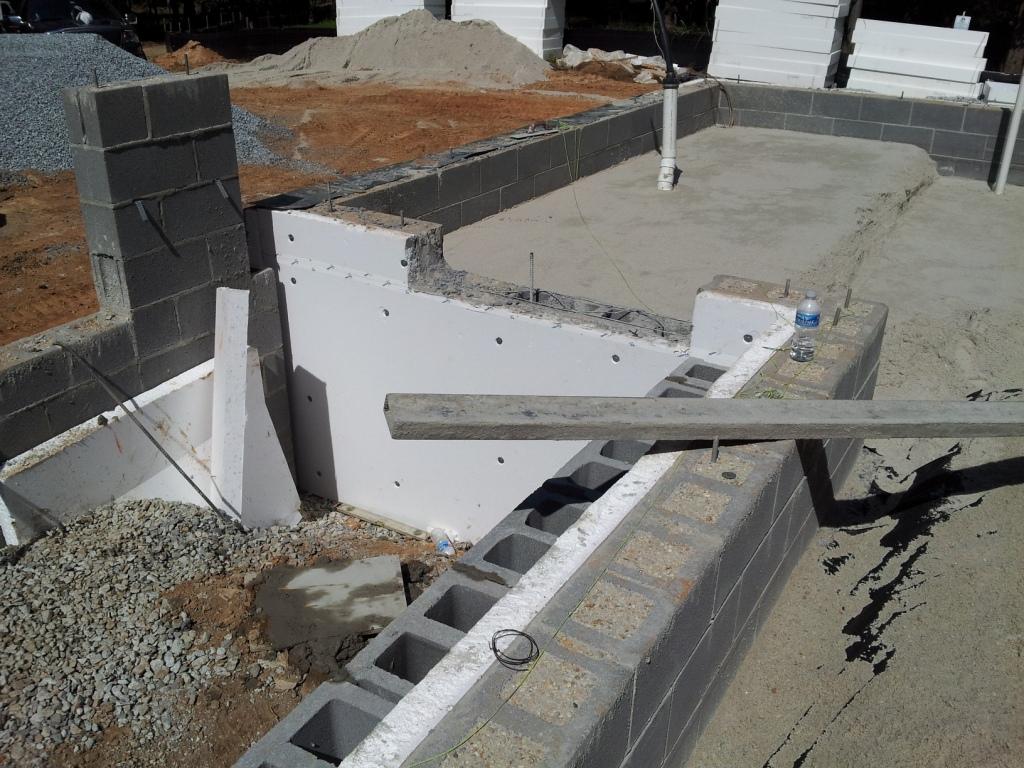
A sand and gravel pillow is made on construction sites with weak soil. It is important to remember that in no case should sand dust or fine-grained sand be used to form it. The ready-to-use mixture must consist of gravel and sand, which have an average particle size. After the pillow from this composition is laid, it will give minimal shrinkage, to ensure which it is necessary to perform careful compaction. Such a foundation for the foundation will perfectly withstand the load of not only a medium-sized house built of frame building materials, beams or logs, but also a structure of a large area, for example, with an attic or second or third floor.
When building a sand and gravel support, you can use this option for carrying out work:
- dig a trench of the required width and depth up to the level of dense soil layers;
- in the moat, which thus turns out, it is necessary to fill in coarse-grained river sand;
- sand should be covered in layers and in small portions. Each layer should be 15 cm thick;
- after laying each new layer, it must be spilled with water;
- all layers are compacted using a special compaction technique;
- the finished support should be 10 mm wider than the planned width of the future building.
The need for a sand and gravel cushion during construction, not only low-rise, but also larger, is due to its relatively affordable cost, high degree of durability and the ability to carry out work on their own, without the help of professional builders. However, it should be borne in mind that such trifles as cleaning the trench after the excavator, backfilling with buckets or wheelbarrows of sand and gravel, manual watering of all layers with water will require serious physical efforts from workers. An attempt to involve household or friends in the process may be quite justified.
DIY sand and gravel pillow
Every experienced master builder knows what a sand and gravel pillow is for. Such a foundation for the foundation is capable of ensuring the building subsequently built fully functioning without defects and damage. It must be remembered that layers of sand and gravel mixture are stacked in layers, but in different thicknesses of each such layer. The fact is that this issue is fundamental for each individual type of soil. In no case should the layer of sand and gravel be less than 5 cm thick.Many builders do not welcome the pillow thickness more than 25 cm.
It is advisable to equip the pillow under the entire building area. It is this method of laying that ensures the most uniform settlement of the structure. The width of such a cushion should be wider than the width of the foundation base by at least 30 cm. Thus, the structure is supported throughout its entire surface area. When laying a sand and gravel cushion, it should be tamped so intensively that it acquired a density equal to 1.6 g / cm3 of the density of soil layers.
When doing this work yourself, monitor the quality of the building materials used. For example, the presence of even a small amount of clay admixture in the sand can lead to serious unpleasant consequences. If water gets into such a pillow, it will begin to swell. Therefore, control the composition and condition of the materials used, and also, be sure to follow the recommendations and step by step instructions at all stages of work. 
Many novice builders think about when and how to make a sand and gravel pillow with their own hands. The solution to this problem is quite accessible to everyone who wishes. And since laying the foundation is the first step towards the construction of any building, a serious and responsible approach is required for its implementation. The depth of the foundation is primarily determined by the level of water flow in the ground. At a great depth of laying the base, one cannot do without a sand and gravel cushion.
Having decided what a sand and gravel cushion is, you can start installing it, which basically boils down to the following:
- it resembles a kind of "pie" with layers of sand and gravel (you can use crushed stone);
- the first layer in a dug trench (foundation pit) is a rubble, which will provide additional strength;
- the second layer is coarse river sand, which, after distribution over the entire surface, must be leveled, poured with water and tamped;
- the third layer, at least 20 cm thick, is gravel. After laying it is tamped using a vibrating plate;
- ready-made layers are covered with a layer of sand equal to 20 cm. After it is poured with water, it settles on gravel.
This technology must be followed layer by layer until the wet sand has nowhere to settle. After the completion of the work on the manufacture of the pillow, you can start building the foundation.
The subtleties of the construction of a shallow foundation
The shallow foundation is a monolithic tape, mainly made of reinforced concrete. The height of such a tape is from 40 to 60 cm, and its width is 35 to 50 cm. These indicators depend on the thickness of the walls and the materials from which they are built. Laying such a base under the building is carried out under all external and internal load-bearing walls.
A very important point in the construction of such a foundation can be called the installation of the correct pillow, in which exclusively non-heaving components should be used. Sand and gravel are ideal ingredients. Moreover, the ratio of these components can be approximately as follows:
- river sand of large fractions - 60%;
- gravel - 40%.
This mixture replaces the soil and is laid on the bottom of the prepared trench. Most often, the trench depth is about 50 cm. All laid materials are tamped. This backfill significantly reduces the effect of heaving forces on the foundation during frost. The sand-gravel mixture neutralizes and springs the impact on the base of the structure from below.
The advantages of a shallow foundation include its low cost and lack of great labor intensity. However, with this choice, the size of the future building is limited, for example, the walls should not exceed 7 m. As for the arrangement of basements, they are not provided for with this type of foundation.
This is not just the foundation of the house, but also the most important part in the entire construction process. country house or any other structure. The durability of any building depends on the correctness of its laying, and a pillow for the foundation plays an important role in this. Its main goal is to create a strong, stable and level ground for the foundation and building in order to ensure as little draft as possible. In this article, we will consider how to make a pillow under the base of the highest quality and most reliable.
Do you need a foundation pillow?
If the foundation was laid poorly or of poor quality, without observing various building codes and regulations, then the building can very quickly fall into disrepair and it will become impossible to live there. In addition, cracks will appear on the walls, the doors will cease to close tightly, the window frames will begin to warp, as a result of which eternal drafts will walk around the house. Therefore, it is necessary to fill quality foundation, and one of the keys to a solid, strong, reliable foundation is a pillow under the foundation.
With the help of such a pillow, you can create an optimal load on the lower part of the foundation. In addition, thanks to the foundation cushion, it is possible to raise the lower part of the base relative to the level, in addition, to completely eliminate the contact of the foundation with construction objects and materials, which is the cause of deformations.
With such a design, you can be sure that the foundation of the house is made as it should, and you don't have to worry about its safety.
How to make a pillow under the foundation
There are three types of foundation cushions: sand, crushed stone and concrete. To level the base of the trench or foundation pit, crushed stone or sand bedding is performed with a thickness of 80-100 mm. A concrete pad is needed if you need to widen the foundation wall or make a reinforced belt for FBS blocks.
Making a crushed stone pillow under the foundation is quite simple.
The top of the finished embankment should be at the bottom elevation of the main structure, while the width of the embankment should be twice as wide as the foundation itself. As a rule, crushed stone bedding is done in 30 cm, of which 5-10 cm is sand, and 20-25 cm is crushed stone.
To make a concrete support, you need to pour crushed stone 5-10 cm thick on a leveled platform and tamp it. Then, according to the size of the fill, we make the formwork, into which we lay the reinforcement along the length. After that, pour concrete. If necessary, reinforcement can be inserted into the concrete, which will connect the concrete support and the foundation.
Foundation cushion thickness
Lay the crushed stone cushion under the foundation so that the level of the already completely finished base is equal to the mark on the project. As a rule, the width of the pillow is wider than the foundation. The thickness of such a pillow should be about 30 cm or more, while 5-10 cm is sand, and the rest is rubble.
The concrete pad will be a denser and more reliable base for the foundation. It will serve you for many years, however, to lay such a foundation, it will take more time and money for consumables... The thickness of this pillow should be higher than 30 cm, and the width is greater than the foundation itself by about 15 cm on each side. For example, if your foundation is 50 cm wide, then the concrete pad should be at least 80 cm wide.
Sand cushion under the foundation
The sand pillow is relatively simple in the device and cheap, therefore it is suitable for those who want to save a little during construction. Despite the low price, this type of pillow perfectly copes with the tasks assigned to it. Its main advantages are protection of the base from erosion and destruction of it by groundwater, as well as providing moderate and not exceeding the norm, namely, on its lower part.
It quite often happens that in a hole dug for laying a foundation there is a layer of soil unsuitable for construction. In this case, unnecessary soil is removed, and sand is laid in its place. It should be remembered that the sand should in no case be fine, but only coarse. The thickness of the cushion for the foundation should be approximately 20-25 cm.
Next, the lining must be carefully leveled so that the layer is even, without excess sand in one area and without dips in another. After that, the sand layer must be well tamped, removing the sand fragility. This is done using a special tool - a vibrating plate. When compacting, the sand layer should be constantly moistened with water, since moisture gives the maximum density to the sand layer.
Gravel cushion under the foundation
This foundation for the foundation of the house is much stronger than the previous one, since the main construction material here is gravel. Before making a pillow under the foundation, it is necessary to prepare the base from a finer material. Coarse river sand is best. It should be covered with a layer of about 10-15 cm, then leveled and tamped. This process is similar to the same step in the construction of a sand bed foundation.
As soon as the sand layer is done properly, gravel should be poured on top of it, the layer of which should be at least 20-25 cm.After that, it should also be leveled and carefully tamped, while making sure that there is a minimum of free space between the gravel stones. Tamping should be done with a vibrating plate.
The underlay for the foundation, that is, the top layer, must be exactly at the zero mark. It is with her that the foundation of the structure will begin in the future.
According to building codes, each side of the gravel pad should exceed its own foundation by about 15-20 cm.
This type of foundation pillow is perfect for any type country houses, of any size and number of storeys. Also, the material from which it is planned to build the building does not matter.
Sand and gravel cushion under the foundation
It should be noted that in no case should fine or dusty sand be used for the foundation pad. If the soil on which you are going to erect the structure is weak, then in this case it is recommended to use a sand and gravel pad on it. It is a mixture of coarse to medium sized sand and gravel or crushed stone.
Such a foundation cushion shrinks almost imperceptibly after laying. For this reason, she needs extra compaction to safely carry the weight of a medium-sized house made of wood or frame. If you plan to make the house bigger and heavier, then it is advisable to compact the gravel foundation cushion.
Concrete pad under the foundation
This type of cushion under the base is characterized by a high degree of strength and reliability. But it has one significant drawback - it's high price.
The device of a concrete pad occurs in the following sequence.
The first step is to prepare the ground. To do this, it must be carefully leveled, then laid on it crushed stone, the thickness of which should not exceed 10 cm. Crushed stone is also well compacted with a vibrating plate.
Further along the perimeter of the foundation cushion, formwork from boards should be placed. The height of the formwork must match the thickness concrete base, that is, not exceed 30 cm. The upper mark of the base should be at the level from which the foundation itself will then begin.
Can be produced for greater strength and durability. This can be done using special metal rods with a diameter of 8-12 mm. At the next stage, you can start pouring the concrete mixture. The concrete grade is calculated based on the weight of the building.
The entire resulting structure should be carefully tamped. To do this, you can use a deep construction vibrator.
A concrete foundation cushion is the most reliable and durable. It can be used for any weight and number of storeys in the house.
The installation of a foundation pillow is considered a very important and painstaking process. A properly selected pillow under the base is a guarantee that you will live in your home for many years without any problems.
One of the necessary base layers for the house is a foundation pillow. It is poured under the slab, and under the tape, and on the bottom of the pits under.
A cushion of sand and / or gravel is made. Its purpose is to compensate for the shrinkage of the house, to protect the base from deformations due to ground movements.
What should be a pillow under the foundation
There are cushions made of gravel, concrete, sand. If, in the process of laying a foundation pit / trench, the builders reach the underlying gravel layer, the pillow can be omitted - its function will be performed by the underlying layer.
What is the best foundation pillow - sand or crushed stone? All materials have their own advantages and disadvantages. The type is chosen at the design stage, taking into account the following features of the object:
- number of storeys of the house;
- type of soil, its characteristics;
- the height of the groundwater;
- climate in the region;
- freezing level, etc.
Pillow functions:
- leveling. If you need to bring the bottom of the pit or trench horizontally, fill in the areas where too much soil has been removed;
- compensating. Due to plasticity, shrinkage is leveled, the consequences of horizontal movements are leveled;
- replacing. In fact, fill soil. When it is impossible to build on the natural layer (for example, it is a peat layer), it is removed and replaced (more often with sand, this is the cheapest option).
Consider the main types of pillows for a strip foundation:
- Sand cushion under the foundation. Evenly distributes the load on the lower part of the base, protects it from erosion by groundwater, and compensates for seasonal swelling of the soil. Allows to reduce construction costs, because sand is cheap and available material... If unsuitable soil is found during trenching, it is removed and the void is filled with coarse sand. If the trench is uneven in depth or the depth exceeds the design, the excess is also covered with sand. When laying a foundation in an area with high groundwater or abundant spring floods under sand pillow pour a layer. More often, this type of pillow is used when groundwater is deeply buried under buildings made of light materials (foam blocks), one-story houses. This type is not suitable for heavy structures.
- Gravel foundation pad. The use of crushed stone allows you to increase the load on the base. This type is suitable for private buildings from any materials and with any number of storeys. In fact, the gravel pad is mixed, because sand in the composition is used too.
- Concrete. This is the most expensive option, but its strength properties and shrinkage resistance are orders of magnitude higher. Also suitable for high-rise buildings.
How to make a pillow under the foundation
The general requirement for pillows of all types: the width is always slightly larger than that of a concrete tape, an indent of about 20 cm is made in each direction. What is required for the device:
- river sand, clay, crushed stone;
- marking cord;
- bayonet and shovel;
- wheelbarrow, buckets;
- hose from a well or well;
- vibrotamper.
Consider the technical features of laying different pillows.
What kind of sand is suitable for a sand pillow?
Choose medium or coarse sand. Dusty is not suitable because it is badly rammed, it is easily saturated with moisture, the layer is unstable.
The second condition is the purity of the material. Large stones, organic impurities, clay should be excluded. The best way - washed river or quarry sand. The purity of the fraction can be determined using a simple test: pour into a transparent vessel, pour water and stir. Clean sand settles to the bottom, clay inclusions form turbidity. If the water remains clear or slightly turbid, the sand can be used for construction purposes.
The thickness of the cushion is usually 25 cm. For a leveling cushion on good ground, 15-20 is sufficient. The poured sand is carefully leveled, moistened and tamped with a vibrating plate. When wetted, the mass of the layer increases, it settles under its own weight and becomes compacted.
What crushed stone is required for a gravel pad?
Varieties of rubble:
- gravel. Affordable cost, high strength, low radiation background;
- granite. The most durable, designed for high loads. Minus - accumulates radiation, albeit on a non-hazardous scale to health;
- lime. The cheapest, frost-resistant. In terms of strength, it loses to others.
Budget option: instead of rubble - broken, which turns out a lot when transporting material for brick houses and fences. Another way to use waste efficiently is to use crushed old concrete in the pad.
For pillows, a fraction of 20-40 millimeters is usually used. In the lower layers the gravel is finer, in the upper layers it is coarser. River sand is poured under the gravel, up to 15 centimeters. The layer must be tamped and leveled. Further - crushed stone, up to 25 cm. Also compacted with a vibrating plate. The last layer reaches the concrete level.
Mixed sand and gravel cushion structure
- The bottom of the foundation pit or trench is laid with rubble stone - small cobblestone (from 15 cm in diameter). Depending on the expected load on the foundation and the depth of the pit, there may be two rubble layers.
- A gravel layer is poured from 10 centimeters thick (optimally 20 cm).
- Sand is poured so that it completely covers the gravel.
- Spill with water.
- If necessary, add more sand and water again. The procedure is repeated until after the spill a continuous sandy "crust" remains on the surface.
- Rammed with a vibrating plate. In her absence, you can use a homemade tool: a steel plate with a rod welded to it with handles for ease of use.
- After tamping, the area is filled with water again.
In some cases, before laying the first (cobblestone) layer, a layer of clay up to 10 cm is placed on the bottom and tamped. The clay layer is waterproof, serves as an additional barrier to groundwater (but does not negate the need for design waterproofing).
How to pour a concrete foundation cushion?
At the first stage, the soil is thoroughly rammed. Then rubble is poured in a layer up to 10 cm and also tamped. Next, concrete is poured.
As with the main foundation, a pillow for strength is possible. An 8 mm bar will do. Basic filling rules:
- the area should be more than the area of \u200b\u200bthe main foundation by about 15 cm on all sides;
- reinforcing rods vertically protrude from the pillow by 20-30 centimeters, they connect the structure with the main foundation.
- Tags:



